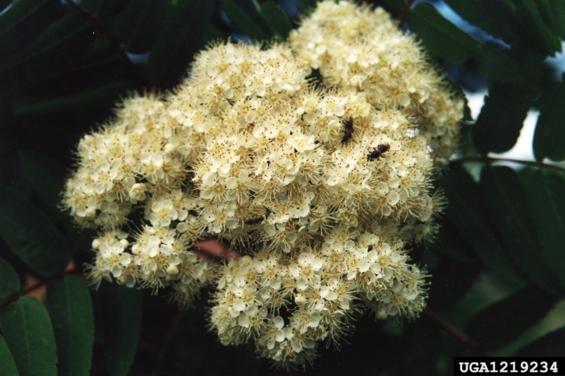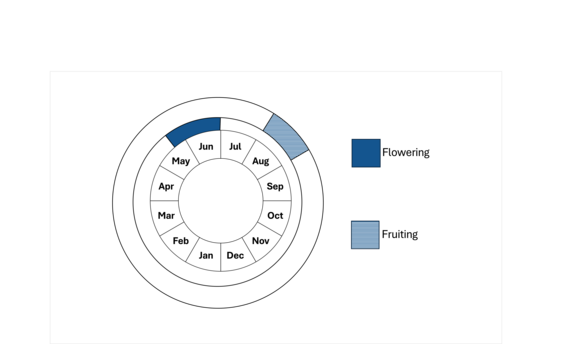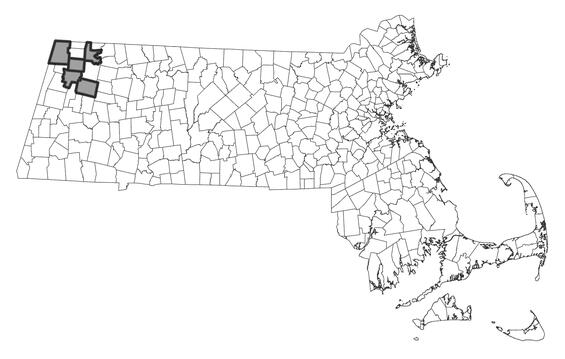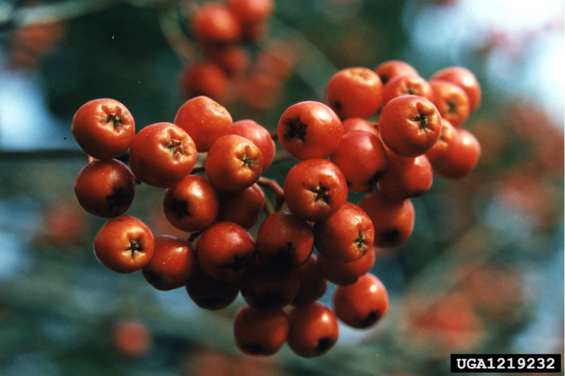- Scientific name: Sorbus decora
- Species of Greatest Conservation Need (MA State Wildlife Action Plan)
Endangered (MA Endangered Species Act)
Description

Northern Mountain-ash inflorescence. Photo: Bill Cook, Michigan State University, Bugwood.org
Northern mountain-ash may be either a tall shrub or a small tree that grows up to 10 m (33 ft) tall and has long pinnately compound leaves. Leaflets are sharply serrated, narrowly oblong, and end in a short sharp point; they are 4-7 cm (1.6-2.8 in) long, dark blue-green above, and pale underneath. Small, white, five-petalled flowers (1 cm [about 0.5 in] wide) are in broad flat-topped clusters with the inflorescence 6-15 cm (2.4-6 in) wide. The fruits are bright reddish-orange, 8-10 mm (0.3-0.4 in) wide, and arranged in clusters.
American mountain-ash (Sorbus americana) closely resembles northern mountain-ash and is fairly widespread on Massachusetts rocky summits. American mountain-ash differs from northern mountain-ash by its medium-green leaflets which are relatively longer, narrower, and much more sharply pointed. The fruits of American mountain-ash are noticeably smaller (4-6 mm; 0.2 in) and the flowering period is about 2 weeks later than northern mountain-ash. Finally, northern mountain-ash has a more rounded overall shape than American mountain-ash.
Life cycle and behavior

Population status
Northern mountain-ash is listed as endangered under the Massachusetts Endangered Species Act. All listed species are protected from killing, collecting, possessing, or sale and from activities that would destroy habitat and thus directly or indirectly cause mortality or disrupt critical behaviors. Massachusetts Natural Heritage & Endangered Species Program database has 7 records from 1 county (Berkshire). Four of those records are within the last 25-year period.
Distribution and abundance
Northern mountain ash is distributed from Newfoundland west to Minnesota and south to Massachusetts, New York, and Iowa. Along the southern extent of the range, it is listed as rare in Vermont, Pennsylvania, and Ohio, and is presumed extirpated in Indiana. NatureServe ranks northern mountain-ash as G4G5, apparently secure.

Distribution in Massachusetts. 1999-2024. Based on records in the Natural Heritage Database.
Habitat

Northern Mountain-ash cluster of reddish-orange fruits. Photo: Bill Cook, Michigan State University, Bugwood.org
Northern mountain-ash grows on mountain slopes in moist or dry rocky soils in northern hardwoods-spruce or spruce-fir forests. In Massachusetts, it is found at higher elevations occurring in thickets, open summits, and along trails and other clearings in forests. Several of the sites are seasonally wet. Usual associates include red spruce (Picea rubens), balsam fir (Abies balsamea), red maple (Acer rubrum), yellow birch (Betula alleghaniensis), American mountain-ash, hobblebush (Viburnum lantanoides), mountain maple (Acer spicatum), mountain holly (Ilex mucronata), black cherry (Prunus serotina), and choke cherry (P. virginiana). Herbaceous associates include bluebead-lily (Clintonia borealis), mountain wood-sorrel (Oxalis montana), spinulose wood-fern (Dryopteris carthusiana), cinnamon fern (Osmunda cinnamomea), hay-scented fern (Dennstaedtia punctilobula), gold thread (Coptis trifolia), Canada mayflower (Maianthemum canadense), and creeping snowberry (Gaultheria hispidula), with the graminoids common hairgrass (Deschampsia flexuosa), New England sedge (Carex novae-angliae), and porcupine sedge (C. hystericina).
Healthy habitats are vital for supporting native wildlife and plants. Explore habitats and learn about conservation and restoration in Massachusetts.
Threats
Current populations are of scattered individuals and are vulnerable to recreational development and succession.
Conservation
All active management of rare plant populations (including invasive species removal) is subject to review under the Massachusetts Endangered Species Act and should be planned in close consultation with the MassWildlife’s Natural Heritage and Endangered Species Program.
References
NatureServe. 2010. NatureServe Explorer: An online encyclopedia of life [web application]. Version 7.1. NatureServe, Arlington, Virginia. Available http://www.natureserve.org/explorer. (Accessed: December 9, 2010 ).
USDA, NRCS. 2010. The PLANTS Database (http://plants.usda.gov, 8 December 2010). National Plant Data Center, Baton Rouge, LA 70874-4490 USA. http://www.plants.usda.gov/java/profile?symbol=SODE3
Contact
| Date published: | May 8, 2025 |
|---|